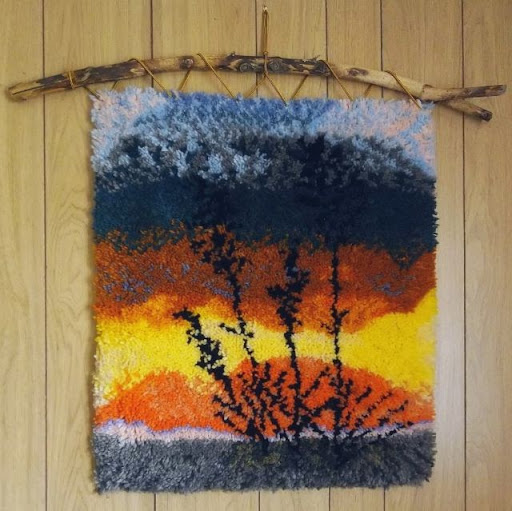 |
| Original Design Latch Hooked Rug, "Delicate Arch in Winter" |
There's almost always a rug in progress in my workshop. I prefer latch-hook rugs, although I've also done them in needlepoint, crochet, punch-needle and braiding. I've recently completed one of Delicate Arch, the iconic rock formation from Arches National Monument near Moab, Utah. The reason that this landmark is so readily recognizable is that there are such limited viewpoints where one can stand to sketch or photograph the arch in its entirety. Few people visit it in winter, but it and its surroundings are spectacular in the snow. I chose to present it as a winter scene with a winter storm in the background. I love the drama of stormy skies and like to incorporate them into my artwork. You may consider the storm as approaching or moving away, whichever you prefer.
I learned to latch-hook as a young girl. A friend had gotten a pillow kit for Christmas that we worked on together. It's a simple skill that, once learned, stays with you for a lifetime. As my friend and I learned, two people can easily work on the same project. If each person pays careful attention to the tension in the knots, no one will ever know where one person's work ends and another's begins. I soon bought kits for their yarn, substituting my own designs and adding to my color range by hand-cutting pieces of Aunt Lydia's or other brands of rug yarns sold in hanks or skeins. I have taught these techniques to a long list of people, ranging from elementary school children to retirees to a woman who was legally blind (but who could still distinguish colors).
 |
| My Latest Latch Hook Work-in-Progress, a Geometric Pattern |
The Impressionists are among my favorite artists. Latch-hooking gives me a medium for doing Impressionistic pictures. The effects can even closely approach pointillism. My favorite subjects are flowers (see previous blogs), wildlife, and landscapes. I don't paint my rug canvases as I sometimes paint my needlepoint canvases. If the rug is to be geometric in design, I graph several complete motifs and work from that, repeating whole or partial motifs as necessary. For realistic pictures, I outline large areas on the canvas with a permanent marker. Then I work “freehand” from my color sketches and J.D.'s photographs, blending my colors as I go. Most yarn today is acrylic (how I miss wool!), but I also use cotton, linen, and novelty yarns for special effects. These need to be cut to length by hand. I also use longer pre-cut rya yarn for texture. It can be hard to find and may need to be ordered from Canadian or European sources.
 |
| My Basic Latch Hooking Tools |
I work on whatever flat surface is available. My most useful tool is a piece of two-by-four lumber with a row of “headless” nails down the center. The nails are spaced to fit into the square openings in the canvas. The wood has been sanded and painted and the bottom covered with felt to keep it from sliding or scratching the work surface. J.D. Made it for me several decades ago. It lifts the canvas off the work surface for easy insertion of the hook. After working a few rows, I lift the canvas off the nails and re-position it. An old muffin tin holds a dozen packs of yarn perfectly. Sharp shears for cutting canvas and yarn, a permanent marker, and a measuring stick complete my tool kit.
 |
| Beginner's Latch Hook, a Small Simple Owl Design |
If you have never done any latch-hooking, I encourage you to give it a try. The easiest way to begin is with a small kit for a pillow or picture. If you enjoy that, I would recommend that you buy some canvas and yarn and start creating designs from charts (cross-stitch or needlepoint charts work well if you allow for the change of scale) or designing original works of your own. They are cheaper than kits! It doesn't take a large investment to begin. I start with a good jute canvas, preferably one which has always been rolled, not folded. The canvas runs $7 to $8 a yard in wide widths. If you watch catalogs like Herrschners or Mary Maxim or visit on-line stores such as Jo-Ann's, you can find pre-cut rug yarn on sale two or three times a year. The yarn comes in standard packs of 320 pieces per pack. Each piece makes one latch-hook knot. Standard rug canvas has 3.75 knot spaces per inch and requires a standard hook ($2). You can also use #5 canvas, sometimes called quickpoint canvas, but it requires a special hook with a smaller head ($3).
Try it. I hope you'll like it! Have fun --- always!
Annake
 |
| Desert Sunset, an Original Latch Hooked Wall Hanging |



